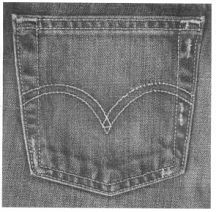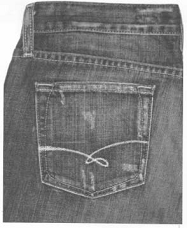
February 2011 Issue
Civil Cases
Levi Strauss & Co. v. Abercrombie & Fitch Trading Co.,
2011 WL 383972 (9th Cir. Feb. 8, 2011)
ABSTRACT
The Ninth Circuit held that the district court’s analysis of a dilution-by-blurring action relating to the stitched design on jean pockets was faulty because it used an outdated test to compare the parties’ marks. The Ninth Circuit announced that the plain language of the Trademark Dilution Revision Act of 2006 (“TDRA”) does not require that the marks at issue in a dilution-by-blurring claim be identical or nearly identical. Rather, under the TDRA, the degree of similarity between the marks is one of several factors a court must balance when evaluating a claim for trademark dilution.
CASE SUMMARY
FACTS
Levi Strauss & Company (“Levi”), the manufacturer of LEVI-brand jeans, uses a famous stitched design on the back pockets of its denim pants, as well as on many other goods. The Levi design, called “Arcuate,” features two connecting arches that meet in the center of the pocket. The Abercrombie & Fitch Trading Company (“Abercrombie”) design, called “Ruehl,” features “two less pronounced arches that are connected by a ‘dipsy doodle,’ which resembles the mathematical sign for infinity.” The respective designs are reproduced below.

ARCUATE |
|
Alleging that the Ruehl stitching too closely mimicked the famous Arcuate mark, Levi filed suit against Abercrombie, including a claim for a violation of the TDRA, among others. Specifically, Levi asserted that Abercrombie’s design diluted the Arcuate mark by blurring its distinctiveness in the marketplace. Relying on Ninth Circuit precedent, Abercrombie countered that dilution claims are available only where the marks at issue are identical or nearly identical, and that because the Ruehl design was not identical or nearly identical to the Arcuate design, Levi could not sustain a claim under the TDRA. The district court, trying the case with the assistance of an advisory jury, found in favor of Abercrombie, accepting the jury’s finding that the marks are not identical or nearly identical and, accordingly, that Levi had not established that the Ruehl design was likely to cause dilution by blurring. Levi appealed the district court’s holding that the TDRA requires the owner of a famous trademark to prove that the allegedly diluting mark is identical or nearly identical.
ANALYSIS
Levi asserted that the TDRA expressly identifies the nonexclusive factors courts are to consider when evaluating a dilution-by-blurring claim. The TDRA does not include the terms “identical or nearly identical” and instead instructs courts to consider “the degree of similarity between the mark or trade name and the famous mark.” 15 U.S.C. § 1125(c)(2)(B)(i). Accordingly, Levi argued that the “degree of similarity” language allows actions against marks that may not be virtually identical but are nonetheless likely to cause dilution by blurring by being sufficiently similar, particularly in light of the other factors that must be considered and balanced.
Abercrombie responded by relying on three post-TDRA Ninth Circuit decisions that utilized the “identical or nearly identical” formulation, namely, Perfumebay.com Inc. v. eBay, Inc., 506 F.3d 1165 (9th Cir. 2007); Jada Toys, Inc. v. Mattel, Inc., 518 F.3d 628 (9th Cir. 2008); and Visa Int’l Serv. Ass’n v. JSL Corp., 2010 WL 2559003 (9th Cir. June 28, 2010). Abercrombie argued that the Ninth Circuit law on this issue was settled because each of the three decisions required the senior user to prove that the junior mark was identical or nearly identical to the senior mark to sustain the claim.
In coming to the conclusion that the TDRA foreclosed the use of the “identical or nearly identical” requirement, the appeals panel recounted the history of the TDRA, including the TDRA’s predecessor, the Federal Trademark Dilution Act (FTDA), and painstakingly distinguished the earlier post-TDRA decisions cited by Abercrombie.
The “identical or nearly identical” standard had been developed in the Ninth Circuit through case law such as Playboy Enterprises, Inc. v. Welles, 279 F.3d 796 (9th Cir. 2002), which held that the mark PLAYMATE OF THE YEAR cannot be diluted by the mark PMOY. The panel noted that Welles relied on an earlier Eighth Circuit decision and McCarthy on Trademarks and Unfair Competition, both of which opined that the target customers must see the marks at issue as “essentially the same.” Subsequently, Thane International v. Trek Bicycle Corp., 305 F.3d 894 (9th Cir. 2002), tied the “identical or nearly identical” standard to the language of the FTDA, and made the requirement virtually unassailable in the Ninth Circuit.
In 2002, however, the Supreme Court’s decision in Moseley v. V Secret Catalogue, Inc., 537 U.S. 418 (2003), gutted the FTDA and, in response thereto, Congress passed the TDRA in 2005. Comparing the FTDA and the TDRA, the Ninth Circuit noted that the TDRA was entirely new legislation that completely overhauled the FTDA, and was not merely a targeted amendment to overturn the Moseley decision. Importantly, the panel noted, despite several appellate cases that relied on the “identical or nearly identical” requirement under the FTDA, the standard is noticeably absent from the TDRA statute. Therefore, the appeals court concluded that “the text of the TDRA articulates a different standard for dilution from that which we utilized under the FTDA.”
Finding that the test articulated by the courts under the FTDA was no longer valid, the panel turned to the three post-TDRA decisions cited by Abercrombie, distinguishing each one and noting that none of them specifically addressed or resolved the issue of whether the “identical or nearly identical” requirement survived the TDRA.
Perfumebay.com had been decided under California state law, which, at the time it was decided, still mirrored the FTDA and had not been amended to more closely follow the TDRA. The appeals court stated that “there simply was no opportunity for us to consider whether a change in the language of the federal statute effected a change in the standard applicable to federal claims.”
The court also distinguished Jada Toys in a similar manner, holding that the case was argued and decided based on the FTDA, not the TDRA. The court was not persuaded by the subsequent amended opinion in Jada Toys, which took into account the effect of the TDRA, finding that the opinion was amended solely to reflect the new “likelihood of dilution” standard set forth in the TDRA. Moreover, the marks at issue in Jada Toys were “nearly identical” and, accordingly, the degree-of-similarity issue was moot.
Finally, the marks at issue in Visa International were found to be “effectively identical,” and Abercrombie relied on that finding to support the argument that the standard continues to be “identical or nearly identical.” However, the panel rejected this reading of the decision, holding that the reference to the marks as being “effectively identical” was not a legal conclusion based on the TDRA standard, but rather “a factual assessment of the similarity of the two marks with which we were presented.”
Holding that FTDA decisions were not binding on the court’s interpretation of the TDRA, the court turned to the language of the TDRA to determine the appropriate test for dilution by blurring. Reviewing the plain language of the statute and rejecting Abercrombie’s reliance on the legislative history of the FTDA and the TDRA, the court held that the statute indicates that “any number of unspecified junior marks may be likely to dilute the senior mark.” Moreover, the court found that the use of the term “similarity” when describing the relationship between the marks at issue in a particular dispute “sets forth a less demanding standard than that employed by many courts under the FTDA.” The court also recognized that Congress made the “degree of similarity” between the marks the first factor, but not the controlling factor, for evaluating a dilution-by-blurring claim. This choice, the court noted, supports the notion that something less than perfect or near identity between a senior mark and a junior mark is enough to assert a claim for dilution by blurring.
Applying the new TDRA standard to this dispute, therefore, the panel noted that the legal error of requiring near identity of the marks permeated the district court’s evaluation of the other TDRA factors, causing a biased and erroneous reading of the statute. Even with this bias, the district court had found in favor of Levi in connection with several factors, including the fame and degree of recognition of the Arcuate mark and the exclusive use of the Arcuate mark. Accordingly, the court remanded the proceedings, holding that, “[g]iven the relative balance of the parties’ positions, we cannot say with any confidence that the district court would have reached the same result absent the legal error.” CONCLUSION
As noted in the opinion, this decision concurs with the Second Circuit’s conclusion in Starbucks Corp. v. Wolfe’s Borough Coffee, Inc., 588 F.3d 97 (2d Cir. 2009), which also held that the requirement of near or exact identity did not survive the enactment of the TDRA. As two appellate courts have now found that the owner of a famous senior mark is not required to show that the junior mark is identical or nearly identical to obtain relief under the TDRA, this standard will likely be difficult to challenge, even outside the Second and Ninth Circuits.
